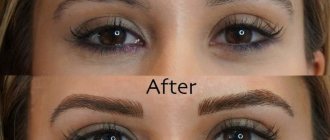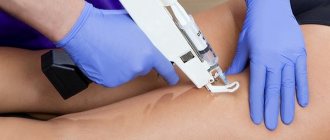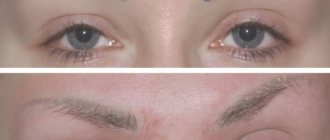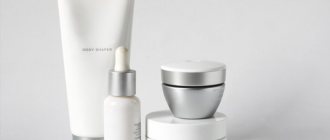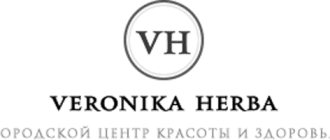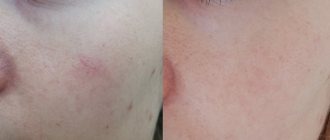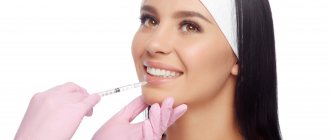What does a laser-removed tattoo look like: does it just fade a little or does white spots or edging appear on it? Are scars a mandatory component of the procedure or can you do without them?
Let's consider how the tattoo area should behave normally after laser treatment, whether it can darken, or even completely change color. Let's talk about what to do if your skin already has a scar from unsuccessful tattoo removal.
Why did the swelling appear?
Swelling after laser tattoo removal of the eyelids or eyebrows is a common reaction of the body and usually goes away the next day. Redness and mild swelling are considered a normal response of the epidermis and immune system when exposed to radiation. This complication is caused by an allergy to the anesthetic cream, as well as high skin sensitivity.
Swelling is common after laser eyebrow tattoo removal. If the inflammation is severe and lasts for four days or more, you should consult a doctor.
The treated area may swell due to an infection acquired during or after the session.
What happens during laser tattoo removal
Laser energy is very powerful. Once on the skin, it is absorbed by certain cells. If a laser pulse lasts a few billionths of a second (that is, a nanosecond), it heats up the molecules that absorb it and explodes them. A microexplosion changes the state of gases dissolved in cells and intercellular substance: oxygen, nitrogen, CO2. They temporarily turn into a gaseous state, becoming bubbles, and then burst. This crushes the tattoo pigment into small particles, and they are safely removed by the lymphatic system.
The appearance of bubbles above the tattoo forms a kind of opaque shield, as a result of which the tattoo fades for 5-10 minutes. After this time, the vacuoles burst and the tattoo darkens again. Sometimes it may even become brighter than before, and this is a normal reaction.
Tattoos removed by laser cannot be returned. If pigment particles are captured by immune cells and removed by lymph, they cannot return to the skin.
Maintaining your privacy is important to us. For this reason, we have developed a Privacy Policy that describes how we use and store your information. Please review our privacy practices and let us know if you have any questions.
Collection and use of personal information
Personal information refers to data that can be used to identify or contact a specific person.
You may be asked to provide your personal information at any time when you contact us.
Below are some examples of the types of personal information we may collect and how we may use such information.
What personal information do we collect:
- When you submit an application on the site, we may collect various information, including your name, phone number, email address, etc.
How we use your personal information:
- The personal information we collect allows us to contact you with unique offers, promotions and other events and upcoming events.
- From time to time, we may use your personal information to send important notices and communications.
- We may also use personal information for internal purposes, such as conducting audits, data analysis and various research in order to improve the services we provide and provide you with recommendations regarding our services.
- If you participate in a prize draw, contest or similar promotion, we may use the information you provide to administer such programs.
Disclosure of information to third parties
We do not disclose the information received from you to third parties.
Exceptions:
- If it is necessary - in accordance with the law, judicial procedure, in legal proceedings, and/or based on public requests or requests from government authorities in the territory of the Russian Federation - to disclose your personal information. We may also disclose information about you if we determine that such disclosure is necessary or appropriate for security, law enforcement, or other public importance purposes.
- In the event of a reorganization, merger, or sale, we may transfer the personal information we collect to the applicable successor third party.
Protection of personal information
We take precautions - including administrative, technical and physical - to protect your personal information from loss, theft, and misuse, as well as unauthorized access, disclosure, alteration and destruction.
Respecting your privacy at the company level
To ensure that your personal information is secure, we communicate privacy and security standards to our employees and strictly enforce privacy practices.
LLC "ET-LASER" INN 9705129176
License No. LO-77-01-018863
Positive and negative sides
Known methods of tattoo removal in the form of exposure to liquid nitrogen, burning with acid, and various types of physical impact leave behind extremely unattractive consequences. Laser tattoo removal naturally has a number of advantages over all other existing methods:
- Complete disappearance of the tattoo.
- Spot removal does not affect the skin around the pattern.
- During the procedure there is no severe pain and there is no blood.
- The effect can be observed after the first procedure.
- Modern devices meet all necessary standards.
The disadvantages include the fairly high cost and the time it takes for the tattoo to completely disappear.
Healing agents
During the first few days after the procedure, the crust on the tattoo needs special care. The specialist can recommend both pharmaceutical products and professional cosmetics. Medicines prevent the growth of bacteria and also promote wound healing.
Professional products alleviate the symptoms of inflammation, they create a protective film, but at the same time moisturize the skin, which eliminates the feeling of tightness. All products used have a safe composition; recommended drugs must be licensed.
Ointments
The most commonly prescribed drugs are Bepanten and Panthenol; there are also analogues Traumeel S and Solcoseryl. These anti-inflammatory drugs are applied in a thin layer to the skin, promoting its regeneration. To prevent infection, there are ointments based on the antibiotic batriacin, but they are used only on the recommendation of a specialist. The pharmacy can offer Baneocin ointment; it also contains Bacitracin.
When using healing ointments, the bark on the tattoo will quickly disappear
Professional ointments are not absorbed as quickly, which allows you to reduce the number of applications.
The most popular products in the tattoo industry:
- Dr. Pro;
- Tattoo Revive;
- Druid Tattoo healing balm;
- Tatoo Goo.
The composition of such drugs includes Chlorhexidine, Panthenol, vitamins, plant extracts and oils.
Healing film
Special films, thanks to their breathable structure, eliminate the need to wrap the skin with compresses, treat the wound with ointments and sprays, and regularly change bandages. The film is removed after the crust on the tattoo begins to come off naturally. Tattoo film has a breathable structure; the film itself does not have a healing effect; it provides protection to the wound from external irritants, thereby starting the process of natural skin regeneration.
The film is tightly fixed to the skin, it does not need to be changed for 5-6 days, and the transparent coating makes it possible to control the healing process. After removal, the skin also needs to be treated with anti-inflammatory agents for 3-4 days.
When using this method, the crust on the tattoo will be hidden under the adhesive sheet, which prevents moisture from entering and tissue friction. The film is removed after the crust on the tattoo begins to come off naturally. However, sometimes the wound heals unevenly, and some of the ichor may remain on the skin. The main task in this case is not to tear off this crust along with the film. You can remove it more delicately and gently after preliminary steaming the desired part of the body.
The main disadvantage of this method is the feeling of discomfort when removing it; the protective film has an adhesive backing. For wounds that have not healed sufficiently, the peeling process will be a little painful.
Popular types of films include:
- Suprasorb F;
- Tattoo Revive Protective Tattoo Film;
- EZ Derm Defender.
The listed products are sold both in rolls and cut-to-length. In the tattoo parlor, the artist will select the required volume of film. The use is not recommended for everyone; specialists often use this material for less voluminous and colored drawings. Due to the multi-color pigments, colors can be mixed under the film, which is not very aesthetically pleasing.
Special plasters
They are used only for attaching medicinal compresses during the healing period. As a separate method for healing the crust on tattoos, adhesive tape is not used, since due to the abundance of glue, the protective ichor layer can be torn off along with the patch.
How a tattoo heals day by day with proper care
The type of care depends on what kind of compress was applied to the tattoo; if it is a healing film, then no manipulations are required for 5-6 days.
Main stages of healing:
| Stages | Duration | Peculiarities |
| Appearance of ichor | Observed for 1-2 days from the date of the procedure | This is a natural process; the resulting liquid may be transparent or mixed with colored pigment. |
| Formation of a protective crust | Lasts up to 4 days | It is strictly forbidden to pick or scratch this area. |
| Peeling | May last 5 to 10 days | The crust on the tattoo begins to gradually peel off. Regeneration is accompanied by slight itching. |
Once the scabs have completely disappeared, the tattoo is considered completely healed. If there are any remaining areas of inflammation, you should continue to treat the area with healing ointment or regularly moisten it with Chlorhexidine.
Miramistin is often prescribed as an antibacterial agent.
What to do if your tattoo is healing too slowly
Each person, due to physiological characteristics, experiences the healing process of a tattoo differently. In due course, the inflamed wound will hurt. The recovery time for the skin is relative - it can take from 2 to 6 weeks.
The client needs to analyze whether there are reasons that prevent proper healing. Perhaps an excessive amount of ointment is applied, which prevents oxygen from entering, or the person constantly covers the tattoo with thick clothing. Even a long shower causes the crust on the tattoo to swell, which is why the inflammation stage lasts a long time.
The problem may be that a person takes medications or drinks alcohol, and the body’s protective functions are disrupted.
What should be the intervals between procedures?
The time frame between procedures is set to allow the skin to recover after exposure. The usual time required for healing is 4-6 weeks. If recovery is slower for various reasons, the doctor will advise you to come back in another week.
If the period between laser tattoo removal procedures is too short, complications are possible - infections, burns, scars and impaired pigmentation of the epidermis.
Between treatment sessions, it is necessary to follow the rules of skin care - protect from the sun, do not treat with aggressive substances, use Bepanten or analogues.
If there is a scar on the skin from unsuccessful tattoo removal?
There are cases when, after laser exposure, a scar remains on the skin filled with pigment from a former tattoo. Picosure allows you to remove this dye so that the scar takes on a natural color and becomes less noticeable. Moreover, the picosecond device will trigger the formation of new skin fibers, as a result of which the scar will become smoother and less noticeable.
Thus, the optimal way to remove a tattoo is a Picosure laser procedure. The device removes tattoos of any color and, in addition, promotes skin rejuvenation. Additionally, it can be used to reduce the severity of scars left after unsuccessful tattoo removal using another method.
What should you be wary of when removing a tattoo?
When set correctly, the laser beam does not heat the skin so much as to cause a burn, which will then turn into a scar. Only swelling and redness will occur and should subside within a short period of time.
You can immediately understand whether a scar will remain after laser tattoo removal. If at the end of the procedure the skin turns pale, the likelihood of scar formation is high.
The following signs indicate that the procedure took place without trauma to the skin:
- the tattoo has changed in color;
- A few minutes after the procedure, the skin became slightly swollen and red.
If you see such changes, do not insist that the specialist continue the procedure. Even if the pigment has changed color dramatically (a red dye containing iron oxide can do this), this is not a reason to prolong the laser treatment session. With subsequent procedures, the brightness of the pigment will decrease.
After laser treatment, the tattoo should gradually fade. There should be no scars or hemorrhages in the skin after the procedure.
In fact, not all lasers are equally dangerous. Most often, scars remain after using nanosecond alexandrite and ruby devices, since they are quite difficult to set up.
What does improper tattoo care lead to in the long-term prognosis?
Neglecting the rules of care leads to the fact that the crust formed on the tattoo will take much longer to come off.
Other consequences include:
- the appearance of scars and cicatrices;
- pigment rejection in the form of an allergic reaction;
- distortion of the picture, faded colors;
- formation of chronic skin diseases.
The causes of complications can be either neglect of the rules by the client or negligence of the master. Professionals must ensure the sterility of instruments and work only with high-quality materials. The crust that forms on a tattoo does not appear immediately, but the possible consequences should be notified during the procedure.
Can tattoos be removed with different lasers? Which is better?
To remove tattoos, you can use various lasers: dye lasers (PDL), neodymium, ruby, nanosecond alexandrite. Each of them has its own wavelength and therefore acts predominantly on pigments of a certain color.
For example, a ruby laser is better at removing blue, green, blue-black, black and violet colors, and it is important that the pigments lie closer to the surface of the skin. The neodymium Q-switched device reduces the brightness of red, orange, violet and blue-black pigments, but does not “see” blue and green colors at all. It turns out that if the tattoo is colored, then to remove it you will have to go to different salons or clinics, first checking what equipment they use?
Not necessary. Not long ago, a fundamentally new type of laser appeared – the Picosure picosecond alexandrite laser. The principle of its operation is a mechanical effect on the skin. The trillionth of a second pulses deliver energy so quickly that the atoms in the treated area of skin move apart, forming plasma bubbles. This breaks the pigment into smaller particles. For example, if after exposure to a Q-switched laser the pigment can be compared to small pebbles, then after PicoSure it will be crushed to the state of sand. Such particles are eliminated much faster by the lymphatic system, which means the result is achieved faster and easier.
Procedure using the Picosure device:
- requires 2-3 times fewer sessions for tattoo removal;
- lasts a short amount of time;
- less painful than with any other laser;
- has a short recovery period - several hours.
As a result of a completely different operating principle, the Picosure picosecond laser can remove pigment of any shade, including rare ones. Clinical studies have proven that Picosure can even remove tattoos that cannot be removed with other types of lasers.
Scars do not form after tattoo removal with a picosecond laser: the skin is not overheated or injured during the procedure.
Possible complications and contraindications
There are some contraindications, the presence of which will make laser removal impossible:
- Epilepsy.
- Colds and chronic aggravated diseases.
- Fresh tan.
- Pregnancy and lactation period.
- Cancer diseases.
- Blood clotting problems.
- The presence of inflammation and wounds on the skin.
- Tendency to scar healing.
What influences the effect?
There are several factors that affect lightening a tattoo with a laser:
- The color of the pigment - the darker it is, the easier it is to get rid of it (not to be confused with the amount of pigment under the skin);
- Paint quality. Professional ink is more resistant to the effects of the beam;
- Driving depth. The deeper the dye penetrates, the more sessions should be performed;
- Client's skin color. In fair-skinned patients the process is much simpler;
- Place of tattoo application - designs on the hips, buttocks, legs, chest, thighs and arms are easier to tattoo. But it is more difficult to remove the pattern on the back, fingers or elbows.
Individual consultation
How to take care of your skin so that crusts do not appear after tattooing
A crust on a tattoo is a natural wound healing process for any person, so it is impossible to exclude the formation of ichor.
To alleviate the condition, the following requirements should be observed:
- Protection. After the tattoo session, the artist applies a protective cream and seals the area with a special absorbent film. This compress should be removed within 2-6 hours.
- Proper healing. After removing the film, the tattoo can be washed with baby or antibacterial soap, but cannot be rubbed. Then, the area should be blotted with an absorbent napkin and a healing ointment should be applied. For 2-4 days, the tattoo should be treated regularly every 6-10 hours. To prevent the protruding mucus from sticking to the fabric of clothing, it is necessary to apply a special or baby diaper over the wound, which can be secured with a medical plaster or masking tape.
- Care during the regeneration stage. After the ichor layer has completely dried, there is no need to apply compresses; for 3 days it is enough to treat the tattoo with a healing ointment.
Compress for tattoo healing
During the recovery period, the skin peels off; you should not steam the wound at this time; you must wear loose clothing and avoid direct sunlight.
Healing time depends on the location of the tattoo, volume, thickness and depth of the lines
Within 1-2 weeks, areas where there is a small amount of subcutaneous fat heal, such as the back, ankle, neck, and elbow joint. Large volume tattoos are usually applied in several stages, so the recovery period takes up to 1 month.
Film for tattoo healing
Fine lines do not greatly injure the dermis, while deep, wide, thick patterns cause more discomfort when applied and take longer to heal. In areas where subcutaneous fat accumulates: on the buttocks, chest, abdomen, tattooing is perceived less painfully, but this does not affect the regeneration period.
